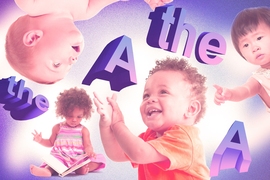If you have the chance, listen to a toddler use the words “a” and “the” before a noun. Can you detect a pattern? Is he or she using those two words correctly?
And one more question: When kids start using language, how much of their know-how is intrinsic, and how much is acquired by listening to others speak?
Now a study co-authored by an MIT professor uses a new approach to shed more light on this matter — a central issue in the area of language acquisition.
The results suggest that experience is an important component of early-childhood language usage although it doesn’t necessarily account for all of a child’s language facility. Moreover, the extent to which a child learns grammar by listening appears to change over time, with a large increase occurring around age 2 and a leveling off taking place in subsequent years.
“In this view, adult-like, rule-based [linguistic] development is the end-product of a construction of knowledge,” says Roger Levy, an MIT professor and co-author of a new paper summarizing the study. Or, as the paper states, the findings are consistent with the idea that children “lack rich grammatical knowledge at the outset of language learning but rapidly begin to generalize on the basis of structural regularities in their input.”
The paper, “The Emergence of an Abstract Grammatical Category in Children’s Early Speech,” appears in the latest issue of Psychological Science. The authors are Levy, a professor in MIT’s Department of Brain and Cognitive Sciences; Stephan Meylann of the University of California at Berkeley; Michael Frank of Stanford University; and Brandon Roy of Stanford and the MIT Media Lab.
Learning curve
Studying how children use terms such as “a dog” or “the dog” correctly can be a productive approach to language acquisition, since children use the articles “a” and “the” relatively early in their lives and tend to use them correctly. Again, though: Is that understanding of grammar innate or acquired?
Some previous studies have examined this specific question by using an “overlap score,” that is, the proportion of nouns that children use with both “a” and “the,” out of all the nouns they use. When children use both terms correctly, it indicates they understand the grammatical difference between indefinite and definite articles, as opposed to cases where they may (incorrectly) think only one or the other is assigned to a particular noun.
One potential drawback to this approach, however, is that the overlap score might change over time simply because a child might hear more article-noun pairings, without fully recognizing the grammatical distinction between articles.
By contrast, the current study builds a statistical model of language use that incorporates not only child language use but adult language use recorded around children, from a variety of sources. Some of these are publicly available copora of recordings of children and caregivers; others are records of individual children; and one source is the “Speechome” experiment conducted by Deb Roy of the MIT Media Lab, which features recordings of over 70 percent of his child’s waking hours.
The Speechome data, as the paper notes, provides some of the strongest evidence yet that “children’s syntactic productivity changes over development” — that younger children learn grammar from hearing it, and do so at different rates during different phases of early childhood.
“I think the method starts to get us traction on the problem,” Levy says. “We saw this as an opportunity both to use more comprehensive data and to develop new analytic techniques.”
A work in progress
Still, as the authors note, a second conclusion of the paper is that more basic data about language development is needed. As the paper notes, much of the available information is not comprehensive enough, and thus “likely not sufficient to yield precise developmental conclusions.”
And as Levy readily acknowledges, developing an airtight hypothesis about grammar acquisition is always likely to be a challenge.
“We’re never going to have an absolute complete record of everything a child has ever heard,” Levy says.
That makes it much harder to interpret the cognitive process leading to either correct or incorrect uses of, say, articles such as “a” and “the.” After all, if a child uses the phrase “a bus” correctly, it still might only be because that child has heard the phrase before and likes the way it sounds, not because he or she grasped the underlying grammar.
“Those things are very hard to tease apart, but that’s what we’re trying to do,” Levy says. “This is only really an initial step.”


![“Children seem to interpret disjunction like conjunction,” observes MIT Linguistics Professor Danny Fox. However, Fox adds, although “it has been claimed children are very different from adults in the interpretation of logical words,” the study’s larger implication is almost the opposite — namely that “the child is [otherwise] identical to the adult, but there is a very small paramet...](/sites/default/files/styles/news_article__archive/public/images/201605/MIT-Language-Acquisition.jpg?itok=3dfJat1o)







